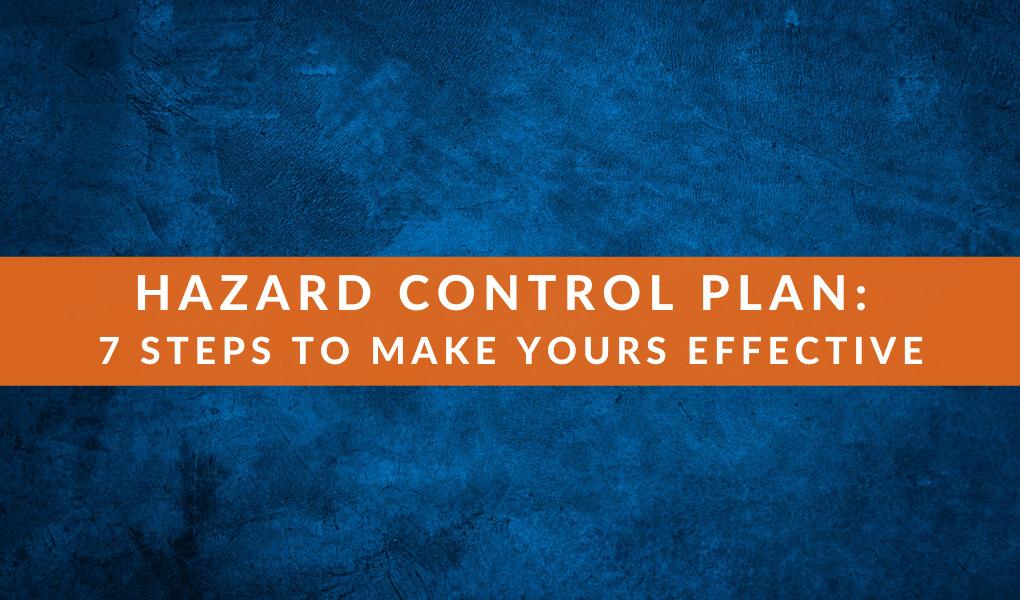
Hazard Control Plan: 7 Steps to Make Yours Effective
A hazard control plan, or HCP, is a set of standard operating procedures that help identify, monitor, and mitigate risks within high-risk environments. When properly implemented, the plan evolves with the work environment, helping to identify new hazards, to quantify risks, and to capture risk mitigation measures.
What is hazard control planning? Although HCPs may differ, the plan creation process usually follows these seven steps:
- Consultation and communication
- Assigning responsibilities
- Establishing a work plan
- Identifying hazards
- Evaluating risks
- Controlling risks
- Reviewing the hazard control plan
Let us look at each step briefly.
#1. Consultation and Communication
Hazard control is only possible within an environment where communication flows freely. As such, the first step in creating an effective HCP is to ensure both employer and employees can openly communicate about workplace safety and health. Within the communication channels, accommodate consultative two-way interactions. These are occasions where management and workers can have candid discussions about health and safety. Establishing strong communication and consultation structures forms the foundation of an effective HCP.
#2. Assign Responsibilities
For a hazard control plan to be effective, it requires ownership. The individual in charge of the program can be a manager, supervisor, or worker. Their primary role is to take responsibility for preparing and implementing the plan. Regardless of who the individual is and their position in the organization, they need three crucial things to succeed as the HCP owner:
- Administrative backing
- Working knowledge of regulatory safety guidelines
- Access to restricted information and areas covered in the HCP
- Approval to allocate resources
#3. Establish a Work Plan
This is a crucial step in learning how to control hazards in the workplace. Establishing a work plan involves two components: determining the scope of hazard control and choosing what to prioritize. Under the scope, it should be clear whether the plan will cover the entire workplace or sections, will it have combined processes or separate processes, and whether to do a project-by-project or hazard-by-hazard implementation. Once the scope is defined, create a hazard prioritization matrix based on the kind of hazards involved, the number of people exposed to each hazard, the number of incidents reported, and the level of risk.
#4. Identify Hazards
A hazard is anything that has the potential to cause harm. Identifying risks should include hazards related to injury, illness, and disease. During the identification process, involve your workers as they often are aware of the dangers associated with their environment and activities. Other ways to identify hazards are workplace inspections, investigating incident reports, borrowing from similar businesses, and using hazard information from suppliers.
#5. Evaluate Risks
Risk evaluation seeks to find out which of the identified hazards represent the highest risk. Some of the ways you can evaluate hazards include asking the following questions:
- How many people are exposed to the hazard?
- How often and for how long are they exposed?
- In what way are they exposed to the hazard?
- Are they exposed to one hazard or a combination?
- What kind of harm does the hazard represent?
- How serious is the potential harm?
- Which type of hazard control measures are currently in place?
From this data, you will know which risks to prioritize as well as the long-term implications each hazard represents.
#6. Control Risks
Risk control should aim to either eliminate or significantly reduce risk. Within the HCP, identify how to mitigate each risk. For example, in a work process involving cutting actions, you can either switch to no-cut materials or use finger-friendly cutting tools. Following OSHA’s safety hierarchy of controls, work down the list from elimination, substitution, engineering controls, administrative controls, down to PPE, and documenting risk control measures for each identified hazard.
#7. Review the Risk Control Plan
Effective risk control plans undergo regular review. A review aims to ensure the list of hazards is current, identify which risk mitigation measures are in place and operational, and determine whether you can implement other more-effective measures to mitigate risk further. The best way to ensure the regular reviews of the plan is to schedule them, allowing enough time to implement any new measures.
Although ensuring that no risk enters the workplace is ideal, it’s not workable in most workplaces. Completing your hazard control plan puts you in control and reduces the risk for everyone.
Download our Safe Cutting Paper to reduce workplace injuries

